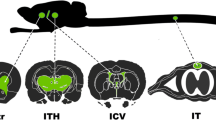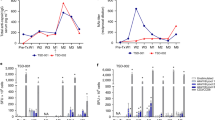Abstract
Intrathecal (IT) gene transfer using adeno-associated virus (AAV) may be clinically promising as a treatment for chronic pain if it can produce sufficiently high levels of a transgene product in the cerebrospinal fluid (CSF). Although this strategy was developed in rodents, no studies investigating CSF levels of an analgesic or antiallodynic protein delivered by IT AAV have been performed in large animals. Interleukin-10 (IL-10) is an antiallodynic cytokine for which target therapeutic levels have been established in rats. The present study tested IT AAV8 encoding either human IL-10 (hIL-10) or enhanced green fluorescent protein (EGFP) in a dog model of IT drug delivery. AAV8/hIL-10 at a dose of 3.5 × 1012 genome copies induced high hIL-10 levels in the CSF, exceeding the target concentration previously found to be antiallodynic in rodents by >1000-fold. AAV8/EGFP targeted the primary sensory and motor neurons and the meninges. hIL-10, a xenogeneic protein in dogs, induced anti-hIL-10 antibodies detectable in the CSF and serum of dogs. The high hIL-10 levels demonstrate the efficacy of AAV for delivery of secreted transgenes into the IT space of large animals, suggesting a strong case for further development toward clinical testing.
This is a preview of subscription content, access via your institution
Access options
Subscribe to this journal
Receive 12 print issues and online access
$259.00 per year
only $21.58 per issue
Buy this article
- Purchase on Springer Link
- Instant access to full article PDF
Prices may be subject to local taxes which are calculated during checkout




Similar content being viewed by others
References
Pizzo PA, Clark NM . Alleviating suffering 101—pain relief in the United States. N Engl J Med 2012; 366: 197–199.
Milligan ED, Penzkover KR, Soderquist RG, Mahoney MJ . Spinal interleukin-10 therapy to treat peripheral neuropathic pain. Neuromodulation 2012; 15: 520–526.
Chacur M, Milligan ED, Sloan EM, Wieseler-Frank J, Barrientos RM, Martin D et al. Snake venom phospholipase A2s (Asp49 and Lys49) induce mechanical allodynia upon peri-sciatic administration: involvement of spinal cord glia, proinflammatory cytokines and nitric oxide. Pain 2004; 108: 180–191.
Laughlin TM, Bethea JR, Yezierski RP, Wilcox GL . Cytokine involvement in dynorphin-induced allodynia. Pain 2000; 84: 159–167.
Kastin AJ, Akerstrom V, Pan W . Interleukin-10 as a CNS therapeutic: the obstacle of the blood–brain/blood–spinal cord barrier. Brain Res Mol Brain Res 2003; 114: 168–171.
Milligan ED, Langer SJ, Sloane EM, He L, Wieseler-Frank J, O’Connor K et al. Controlling pathological pain by adenovirally driven spinal production of the anti-inflammatory cytokine, interleukin-10. Eur J Neurosci 2005; 21: 2136–2148.
Milligan ED, Sloane EM, Langer SJ, Hughes TS, Jekich BM, Frank MG et al. Repeated intrathecal injections of plasmid DNA encoding interleukin-10 produce prolonged reversal of neuropathic pain. Pain 2006; 126: 294–308.
Soderquist RG, Milligan ED, Harrison JA, Chavez RA, Johnson KW, Watkins LR et al. PEGylation of interleukin-10 for the mitigation of enhanced pain states. J Biomed Mater Res A 2010; 93: 1169–1179.
Milligan ED, Soderquist RG, Malone SM, Mahoney JH, Hughes TS, Langer SJ et al. Intrathecal polymer-based interleukin-10 gene delivery for neuropathic pain. Neuron Glia Biol 2006; 2: 293–308.
Storek B, Reinhardt M, Wang C, Janssen WGM, Harder NM, Banck MS et al. Sensory neuron targeting by self-complementary AAV8 via lumbar puncture for chronic pain. Proc Natl Acad Sci USA 2008; 105: 1055–1060.
Zhou Z, Peng X, Hao S, Fink DJ, Mata M . HSV-mediated transfer of interleukin-10 reduces inflammatory pain through modulation of membrane tumor necrosis factor α in spinal cord microglia. Gene Therapy 2007; 15: 183–190.
Lau D, Harte SE, Morrow TJ, Wang S, Mata M, Fink DJ . Herpes simplex virus vector-mediated expression of interleukin-10 reduces below-level central neuropathic pain after spinal cord injury. Neurorehabil Neural Rep 2012; 26: 889–897.
Samaranch L, Salegio EA, San Sebastian W, Kells AP, Bringas J, Forsayeth J et al. Strong cortical and spinal cord transduction after AAV7 and AAV9 delivery into the CSF of non-human primates. Hum Gene Ther 2013: 24: 526–532.
Federici T, Taub JS, Baum GR, Gray SJ, Grieger JC, Matthews KA et al. Robust spinal motor neuron transduction following intrathecal delivery of AAV9 in pigs. Gene Therapy 2011: 19: 852–859.
Gray SJ, Nagabhushan Kalburgi S, McCown TJ, Jude Samulski R . Global CNS gene delivery and evasion of anti-AAV-neutralizing antibodies by intrathecal AAV administration in non-human primates. Gene Therapy 2013: 20: 450–459.
Samaranch L, Salegio EA, San Sebastian W, Kells AP, Foust KD, Bringas JR et al. Adeno-associated virus serotype 9 transduction in the central nervous system of nonhuman primates. Hum Gene Ther 2012; 389: 382–389.
Haurigot V, Marcó S, Ribera A, Garcia M, Ruzo A, Villacampa P et al. Whole body correction of mucopolysaccharidosis IIIA by intracerebrospinal fluid gene therapy. J Clin Invest 2013; 123: pii 66778.
Vulchanova L, Schuster DJ, Belur LR, Riedl MS, Podetz-Pedersen KM, Kitto KF et al. Differential adeno-associated virus mediated gene transfer to sensory neurons following intrathecal delivery by direct lumbar puncture. Mol Pain 2010; 6: 31.
Jacques SJ, Ahmed Z, Forbes A, Douglas MR, Vigenswara V, Berry M et al. AAV8(gfp) preferentially targets large diameter dorsal root ganglion neurones after both intra-dorsal root ganglion and intrathecal injection. Mol Cell Neurosci 2012; 49: 464–474.
Gray SJ, Matagne V, Bachaboina L, Yadav S, Ojeda SR, Samulski RJ . Preclinical differences of intravascular AAV9 delivery to neurons and glia: a comparative study of adult mice and nonhuman primates. Mol Ther 2011; 19: 1058–1069.
Milligan ED, Sloane EM, Langer SJ, Cruz PE, Chacur M, Spataro L et al. Controlling neuropathic pain by adeno-associated virus driven production of the anti-inflammatory cytokine, interleukin-10. Mol Pain 2005; 1: 9.
Finegold AA, Mannes AJ, Iadarola MJ . A paracrine paradigm for in vivo gene therapy in the central nervous system: treatment of chronic pain. Hum Gene Ther 1999; 10: 1251–1257.
Chen G, Castro WL, Chow HH, Reichlin S . Clearance of 125I-labeled interleukin-6 from brain into blood following intracerebroventricular injection in rats. Endocrinology 1997; 138: 4830–4836.
Carare RO, Hawkes CA, Weller RO . Afferent and efferent immunological pathways of the brain. Anatomy, function and failure. Brain Behav Immun 2014; 36: 9–14.
Günther G, Haglund M, Lindquist L, Forsgren M, Andersson J, Andersson B et al. Tick-borne encephalitis is associated with low levels of interleukin-10 in cerebrospinal fluid. Infect Ecol Epidemiol 2011; 1: 1–6.
Zin CS, Nissen LM, O’Callaghan JP, Moore BJ, Smith MT . Preliminary study of the plasma and cerebrospinal fluid concentrations of IL-6 and IL-10 in patients with chronic pain receiving intrathecal opioid infusions by chronically implanted pump for pain management. Pain Med 2010; 11: 550–561.
Huhn RD, Radwanski E, O’Connell SM, Sturgill MG, Clarke L, Cody RP et al. Pharmacokinetics and immunomodulatory properties of intravenously administered recombinant human interleukin-10 in healthy volunteers. Blood 1996; 87: 699–705.
Rosenblum IY, Johnson RC, Schmahai TJ . Preclinical safety evaluation of recombinant human interleukin-10. Regul Toxicol Pharmacol 2002; 35: 56–71.
Hadaczek P, Forsayeth J, Mirek H, Munson K, Bringas J, Pivirotto P et al. Transduction of nonhuman primate brain with adeno-associated virus serotype 1: vector trafficking and immune response. Hum Gene Ther 2009; 20: 225–237.
Yaksh TL, Rathbun ML, Dragani JC, Malkmus S, Bourdeau AR, Richter P et al. Kinetic and safety studies on intrathecally infused recombinant-methionyl human brain-derived neurotrophic factor in dogs. Fundam Appl Toxicol 1997; 38: 89–100.
Ciron C, Desmaris N, Colle M-A, Raoul S, Joussemet B, Vérot L et al. Gene therapy of the brain in the dog model of Hurler’s syndrome. Ann Neurol 2006; 60: 204–213.
Ellinwood NM, Ausseil J, Desmaris N, Bigou S, Liu S, Jens JK et al. Safe, efficient, and reproducible gene therapy of the brain in the dog models of Sanfilippo and Hurler syndromes. Mol Ther 2011; 19: 251–259.
Re F, Srinivasan R, Igarashi T, Marincola F, Childs R . Green fluorescent protein expression in dendritic cells enhances their immunogenicity and elicits specific cytotoxic T-cell responses in humans. Exp Hematol 2004; 32: 210–217.
Stripecke R, Carmen Villacres M, Skelton D, Satake N, Halene S, Kohn D . Immune response to green fluorescent protein: implications for gene therapy. Gene Therapy 1999; 6: 1305–1312.
Gambotto A, Dworacki G, Cicinnati V, Kenniston T, Steitz J, Tüting T et al. Immunogenicity of enhanced green fluorescent protein (EGFP) in BALB/c mice: identification of an H2-Kd-restricted CTL epitope. Gene Therapy 2000; 7: 2036–2040.
Davidoff AM, Gray JT, Ng CYC, Zhang Y, Zhou J, Spence Y et al. Comparison of the ability of adeno-associated viral vectors pseudotyped with serotype 2, 5, and 8 capsid proteins to mediate efficient transduction of the liver in murine and nonhuman primate models. Mol Ther 2005; 11: 875–888.
Nathwani AC, Rosales C, McIntosh J, Rastegarlari G, Nathwani D, Raj D et al. Long-term safety and efficacy following systemic administration of a self-complementary AAV vector encoding human FIX pseudotyped with serotype 5 and 8 capsid proteins. Mol Ther 2011; 19: 876–885.
Nathwani AC, Gray JT, Ng CYC, Zhou J, Spence Y, Waddington SN et al. Self-complementary adeno-associated virus vectors containing a novel liver-specific human factor IX expression cassette enable highly efficient transduction of murine and nonhuman primate liver. Blood 2006; 107: 2653–2661.
Wiese AJ, Rathbun M, Butt MT, Malkmus SA, Richter PJ, Osborn KG et al. Intrathecal substance p-saporin in the dog: distribution, safety, and spinal neurokinin-1 receptor ablation. Anesthesiology 2013; 119: 1163–1177.
Allen JW, Mantyh PW, Horais K, Tozier N, Rogers SD, Ghilardi JR et al. Safety evaluation of intrathecal substance P-saporin, a targeted neurotoxin, in dogs. Toxicol Sci 2006; 91: 286–298.
Rijsdijk M, van Wijck AJ, Kalkman CJ, Meulenhoff PC, Grafe MR, Steinauer J et al. Safety assessment and pharmacokinetics of intrathecal methylprednisolone acetate in dogs. Anesthesiology 2012; 116: 170–181.
Yaksh TL, de Kater A, Dean R, Best BM, Miljanich GP . Pharmacokinetic analysis of ziconotide (SNX-111), an intrathecal N-type calcium channel blocking analgesic, delivered by bolus and infusion in the dog. Neuromodulation 2012; 15: 508–519.
Kern SE, Allen J, Wagstaff J, Shafer SL, Yaksh T . The pharmacokinetics of the conopeptide contulakin-G (CGX-1160) after intrathecal administration: an analysis of data from studies in beagles. Anesth Analg 2007; 104: 1514–1520; table of contents.
Yaksh TL, Allen JW, Veesart SL, Horais Ka, Malkmus Sa, Scadeng M et al. Role of meningeal mast cells in intrathecal morphine-evoked granuloma formation. Anesthesiology 2013; 118: 664–678.
Pleticha J, Jeng-Singh C, Rezek R, Zaibak M, Beutler AS . Intraneural convection enhanced delivery of AAVrh20 for targeting primary sensory neurons. Mol Cell Neurosci 2014; 60: 72–80.
Acknowledgements
The study was supported by NIH Grant R01NS063022 and funds from the Schulze Family Foundation. We thank the anonymous reviewer for pointing toward the literature on cytokine exit from the CSF to the general circulation and references 23 and 24 included in the revised version of the manuscript.
Author information
Authors and Affiliations
Corresponding author
Ethics declarations
Competing interests
The authors declare no conflict of interest.
Additional information
Supplementary Information accompanies this paper on Gene Therapy website
Supplementary information
Rights and permissions
About this article
Cite this article
Pleticha, J., Malkmus, S., Heilmann, L. et al. High cerebrospinal fluid levels of interleukin-10 attained by AAV in dogs. Gene Ther 22, 202–208 (2015). https://doi.org/10.1038/gt.2014.96
Received:
Revised:
Accepted:
Published:
Issue Date:
DOI: https://doi.org/10.1038/gt.2014.96
This article is cited by
-
Inhibition of neuropathic hyperalgesia by intrathecal bone marrow stromal cells is associated with alteration of multiple soluble factors in cerebrospinal fluid
Experimental Brain Research (2017)
-
Current Gene Therapy using Viral Vectors for Chronic Pain
Molecular Pain (2015)



